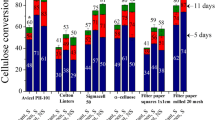Summary
The use of a column cellulose hydrolysis reactor with continuous enzyme recycling was demonstrated by incorporating a continuous ultrafiltration apparatus at the effluent end of the column reactor. Using this setup, over 90% (w/v) cellulose hydrolysis was achieved, resulting in an average sugar concentration of 6.8% (w/v) in the effluent stream. The output of the system was 1.98 g of reducing sugar/l/h with a ratio of 87% (w/v) of the reducing sugars being monomeric sugars. Batch hydrolysis reactors were less effective, resulting in 57% (w/v) of the cellulose being hydrolyzed. The output of the batch reactor was 1.33 g of reducing sugar/l/h with similar product concentrations and percentage of monomeric sugars. The ratio of reducing sugar/filter paper unit of cellulase activity for the column method was 69.1 mg/U as compared to only 21.2 mg/U for the batch reactor.
Similar content being viewed by others
References
Alfani F, Cantarella M, Scardi V (1983) Use of a membrane reactor for studying enzymatic hydrolysis of cellulose. J Membrane Science 16:407–416
Berghem LER, Pettersson LG, Axio-Fredriksson U-B (1975) The mechanism of enzymatic cellulose degradation. Characterization and enzymatic properties of a β-1,4-glucan cellobiohydrolase from Trichoderma viride. Eur J Biochem 53:55–62
Detroy RW, St Julian G (1983) Biomass conversion: fermentation chemicals and fuels. CRC Crit Rev Microbiol 10:203–260
Gusakov AV, Nadzhemi B, Sinitsyn AP, Klesov AA (1984) Comparison of the effectiveness of the enzymatic hydrolysis of cellulose in laboratory setups of various types. Appl Biochem Microbiol 20:44–51
Henley RG, Yang RYK, Greenfield PF (1980) Enzymatic saccharification of cellulose in membrane reactors. Enzyme Microb Technol 2:206–208
Mandels M, Kostick J, Parizek R (1971) The use of adsorbed cellulase in the continuous conversion of cellulose to glucose. J Polymer Sci: Part C 36:445–459
Mandels M, Andreotti R, Roche C (1976) Measurement of saccharifying cellulose. Biotechnol Bioeng Symp 6:2–34
Miller GL (1959) Use of dinitrosalicylic reagent for the determination of reducing sugars. Anal Chem 31:426–428
Nelson N (1944) A photometric adaptation of the Somogyi method for the determination of glucose. J Biol Chem 153:375–380
Ohlson I, Tragardh G, Hahn-Hagerdal B (1984) Enzymatic hydrolysis of sodium hydroxide pretreated sallow in an ultrafiltration membrane reactor. Biotechnol Bioeng 26:647–653
Saddler JN, Brownell HH, Clermont LP, Levitin N (1982) Enzymatic hydrolysis of cellulose and various pretreated wood fractions. Biotechnol Bioeng 24:1389–1402
Sandhya S, Joshi SR, Swaminathan T (1984) J of Scientific and Industrial Research 43:452–458
Somogyi M (1952) Notes on sugar determination. J Biol Chem 195:19–23
Author information
Authors and Affiliations
Rights and permissions
About this article
Cite this article
Tan, L.U.L., Yu, E.K.C., Campbell, N. et al. Column cellulose hydrolysis reactor: An efficient cellulose hydrolysis reactor with continuous cellulase recycling. Appl Microbiol Biotechnol 25, 250–255 (1986). https://doi.org/10.1007/BF00253658
Received:
Revised:
Issue Date:
DOI: https://doi.org/10.1007/BF00253658




